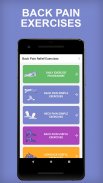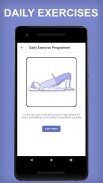











Back Pain Relief Exercises

Description of Back Pain Relief Exercises
পিঠে ব্যথা একটি সাধারণ সমস্যা যা অনেক লোক প্রতিদিন মোকাবেলা করে। ব্যায়াম প্রায়ই নীচের পিঠের ব্যথা কমাতে এবং আরও অস্বস্তি প্রতিরোধ করতে সাহায্য করে। নিম্নলিখিত ব্যায়ামগুলি পিছনে এবং এটি সমর্থনকারী পেশীগুলিকে প্রসারিত এবং শক্তিশালী করে।
আপনি যখন প্রথম শুরু করেন, প্রতিটি ব্যায়াম কয়েকবার পুনরাবৃত্তি করুন। তারপরে আপনি যতবার অনুশীলন করবেন ততবার বাড়ান কারণ এটি আপনার পক্ষে সহজ হয়ে যায়। যদি আপনি চলমান উপরের পিঠে ব্যথার কারণে বা পিঠে আঘাতের কারণে একটি ব্যায়াম প্রোগ্রাম শুরু করেন, তাহলে আপনার জন্য নিরাপদ কার্যকলাপ সম্পর্কে একজন শারীরিক থেরাপিস্ট বা আপনার স্বাস্থ্যসেবা দলের অন্য সদস্যের সাথে কথা বলুন।
পিঠের নীচের অংশ এবং নিতম্বের ব্যথার জন্য ব্যায়ামগুলি এমন কিছু যা আপনার দৈনন্দিন রুটিনে অন্তর্ভুক্ত করা উচিত, বিশেষ করে যদি আপনি ব্যথা অনুভব করেন যেমন সায়াটিকা ব্যথা বা শক্ত হয়ে যাওয়া, বা আপনি যদি সবে বয়স্ক হতে শুরু করেন, পিঠের নীচের অনেক কারণের মধ্যে একটি। ব্যথা এই ব্যায়ামগুলি আপনার বেশি সময় নিতে হবে না।
পিঠের নিচের পিঠে ব্যথা সাধারণ, এবং অনেক কিছু এটির কারণ হতে পারে। নির্দিষ্ট প্রসারিত পিঠের ব্যথা উপশম করতে পারে এবং স্ফীত পেশীগুলির নমনীয়তা উন্নত করতে পারে।
নীচের ডান পিঠের সমস্যায় যে কোনও ব্যথার পরে, পিছনের উপরের পেশীগুলির নড়াচড়া এবং শক্তি অর্জন করা গুরুত্বপূর্ণ। এটি টিস্যু নিরাময় সমর্থন করে এবং আপনাকে আবার চলতে সাহায্য করবে।
আপনি অবিলম্বে আপনার স্বাভাবিক ব্যায়ামের স্তরে ফিরে আসতে সক্ষম নাও হতে পারেন এবং উন্নতিগুলি শুরু করতে ধীর হতে পারে। যাইহোক, স্বাভাবিক ক্রিয়াকলাপে ধীরে ধীরে ফিরে আসা হল পিঠের সমস্যায় পেশীতে খিঁচুনি হওয়ার পরে ভাল স্বল্প এবং দীর্ঘমেয়াদী ফলাফল পাওয়ার সর্বোত্তম উপায়।
ব্যায়াম করার সময় আপনার উপরের মাঝামাঝি পিঠের ব্যথার মাত্রা শুনতে হবে, বিশেষ করে প্রাথমিক পর্যায়ে। আপনি দেখতে পাবেন যে এই ব্যায়ামগুলি শুরুতে আপনার লক্ষণগুলিকে কিছুটা বাড়িয়ে দেয়। যাইহোক, তারা সময়ের সাথে সহজ হওয়া উচিত এবং, নিয়মিত অনুশীলনের সাথে, পিছনে নড়াচড়া উন্নত করতে সাহায্য করতে পারে।
যদি ব্যায়ামগুলি কিছু অস্বস্তি সৃষ্টি করে তবে আপনার জিপি বা ফার্মাসিস্টের নির্দেশিত ওষুধ গ্রহণ আপনাকে ব্যায়াম চালিয়ে যেতে সাহায্য করতে পারে।

























